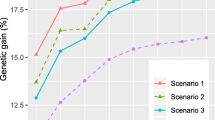Abstract
Maximizing genetic gain at an acceptable diversity level is an ideal outcome of selection and deployment. Based on this criterion, this study investigated the efficiency of unequal clonal deployment strategies for clonal forestry and compared them with truncation selection and equal deployment (truncation deployment). Two unequal deployment strategies were considered: (1) deploying the clones in linear relationship to their genetic values (linear deployment) and (2) optimizing genetic gain at a given diversity level using an algorithm (optimal deployment). All strategies were applied to candidate clone sets constructed from two clonal tests of spruces with one having a complex relationship of clone, half-sib, and full-sib and the other having a simpler relationship of clone and half-sib. At a constant diversity level, substantially more expected gains were obtained by the unequal deployment strategies than by truncation deployment. Optimal deployment was at least equal to linear deployment. Optimal deployment’s superiority was more evident when the candidate clones in the set were more closely related, having less available diversity for selection, and/or when higher diversity levels were demanded, but diminished when the candidate clones were unrelated or equally related. We recommend using optimal deployment for clonal forestry, although in some cases, linear deployment might be a near-optimal alternative. As current clonal tests are based on advanced breeding cycles, candidate clones for selection are inevitably related to some degree, so optimal deployment is likely to become preferred.

Similar content being viewed by others
References
Danusevičius D, Lindgren D (2008) Strategies for optimal deployment of related clones into seed orchards. Silvae Genet 57:119–127
Funda T, Lstibůrek M, Lachout P, Klápštĕ J, EI-Kassaby YA (2009) Optimization of combined genetic gain and diversity for collection and deployment of seed orchard crops. Tree Genet Genom 5:583–593
Hallander J, Waldmann P (2009) Optimum contribution selection in large general tree breeding populations with an application to Scots pine. Theor Appl Genet 118:1133–1142
Kerr RJ, Goddard ME, Jarvis SF (1998) Maximizing genetic responses in tree breeding with constraints on group coancestry. Silvae Genet 47:165–173
Lindgren D (2009) A way to utilise the advantages of clonal forestry for Norway spruce. Vegetative propagation of conifers for enhancing landscaping and tree breeding. In: Aronen T, Nikkanen T, Tynkkynen T (eds) Proceedings of the Nordic meeting held in 10–11 Sept 2008. Punkaharju, Finland
Lindgren D, Matheson AC (1986) An algorithm for increasing the genetic quality of seed from seed orchards by using the better clones in higher proportions. Silvae Genet 35:173–175
Lindgren D, Mullin TJ (1997) Selection for coancestry-adjusted performance to combine genetic gain and effective population size. Silvae Genet 46:124–129
Lindgren D, Libby WS, Bondesson FL (1989) Development to plantations of numbers and proportions of clones with special emphasis on maximizing gain at a constant diversity. Theor Appl Genet 77:825–831
Lindgren D, Danusevičius D, Rosvall O (2009) Unequal deployment of clones to seed orchards by considering genetic gain, relatedness and gene diversity. Forestry 82:17–28
Meuwissen TH (1997) Maximizing the response of selection with a predefined rate of inbreeding. J Anim Sci 75:934–940
Mullin TJ, Morgenstern EK, Park YS, Fowler DP (1992) Genetic parameters from a clonally replicated test of black spruce (Picea mariana). Can J For Res 22:24–36
Park YS, Fowler DP (1987) Genetic variances among clonally propagated populations of tamarack and the implications for clonal forestry. Can J For Res 17:1175–1180
Prescher F, Lindgren D, Karlsson B (2008) Genetic thinning of clonal seed orchards using linear deployment may improve both gain and diversity. For Ecol Manage 254:188–192
Stoehr M, Yanchuk A, Xie CY (2008) Gain and diversity in advanced generation coastal Douglas-fir selections for seed production populations. Tree Genet Genom 4:193–200
Varghese M, Lindgren D, Ravi N (2006) Linear thinning in a clonal test of Eucalyptus camaldulensis for conversion to a clonal seed orchard. J Trop For Sci 18:102–108
Weng YH, Park YS, Krasowski MJ, Tosh KJ, Adams G (2008) Partitioning of genetic variance and selection efficiency for alternative vegetative deployment strategies for white spruce in eastern Canada. Tree Genet Genom 4:809–819
Weng YH, Park YS, Krasowski MJ (2010) Managing genetic gain and diversity in white spruce multi-varietal forestry in New Brunswick. Tree Genet Genom 6:367–376
White TL, Adams WT, Neale DB (2007) Forest genetics. CABI, Cambridge
Zheng YQ, Lindgren D, Rosvall O, Westin J (1997) Combining genetic gain and diversity by considering average coancestry in clonal selection of Norway spruce. Theor Appl Genet 95:1312–1319
Acknowledgments
We thank Dale Simpson and John Major for their valuable comments on an earlier version of the manuscript and Caroline Simpson for editing. Valuable comments/suggestions from Dr. R. Burdon and three reviewers are also gratefully acknowledged.
Author information
Authors and Affiliations
Corresponding authors
Additional information
Communicated by R. Burdon
Rights and permissions
About this article
Cite this article
Weng, Y., Park, Y.S. & Lindgren, D. Unequal clonal deployment improves genetic gains at constant diversity levels for clonal forestry. Tree Genetics & Genomes 8, 77–85 (2012). https://doi.org/10.1007/s11295-011-0422-2
Received:
Revised:
Accepted:
Published:
Issue Date:
DOI: https://doi.org/10.1007/s11295-011-0422-2




